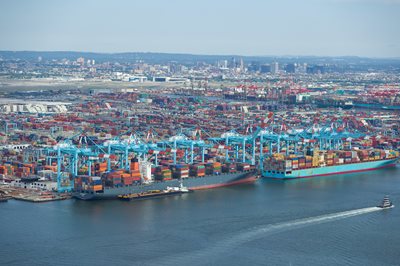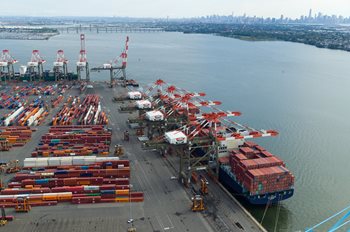After the bridge collapse in Baltimore, about 65 percent of the containers heading to that city’s port have been diverted to the
Port of New York and New Jersey, which has the capacity to help handle that cargo as well as expected future growth.

Those were among the insights offered in the annual port industry update at
NJTPA’s Freight Initiatives Commitee (FIC) meeting on April 15. The presenters were Beth Rooney, Port Director for the Port Authority of New York and New Jersey, and John Nardi, President of the
Shipping Association of New York and New Jersey.
The Port of New York and New Jersey is the second busiest in the United States, in cargo volume. According to Rooney, that volume surged by 28 percent over 2019 levels during the pandemic, severely straining the port’s capacity. During the past year the growth has moderated to a level 4.4 percent higher than pre-pandemic volumes in 2019. Port traffic also includes 3.1 million metric tons of bulk cargo, more than 1 million cruise passengers, and 367,000 automobiles.
Response to Baltimore
In response to the Francis Scott Key Bridge collapse in Baltimore late last month, Port Newark added additional hours and Saturday gates to handle the increase in containers. There’s “more than enough capacity” at the port to address Baltimore’s needs, Rooney said, noting that the ships were already stopping in New Jersey, they’re just offloading more cargo here now.
To date, the port has issued credentials for about 450 Baltimore truckers now coming to its facilities to pick up cargo originally destined for Baltimore. Norfolk Southern and CSX also have added shuttle trains to move cargo between the ports.
The port is committed to receiving a third of the automobiles that otherwise would have gone to Baltimore, the nation’s largest port for processing cars and trucks. Many of the diverted vehicles are being trucked on car-carriers back to Baltimore for processing, helping sustain that port’s labor force, she said.
From Shortage to Surplus
“We’re in a very unusual situation for this port,” Nardi said, after the “volume pendulum” swung last year from record cargo volumes to a sharp decline. “We quickly went from daily [labor] shortages and a burned-out workforce to having a surplus of longshoremen,” he said, as many as 400 a day.

This year, the association has shifted focus to worker retention recognizing that its pool of trained and experienced workers cannot be easily replaced. It has turned to spending $10 to $15 million training all workers, whether actively working or not, on specialized machinery.
“It looks like ‘Star Wars’ with the type of machinery people are operating,” Nardi said. There were 825 new certifications for handling the equipment in 2023 and 2,130 recertifications. Almost 2,000 workers were trained or retrained. If normal growth occurs, Nardi suggested these workers should find a permanent home or sustainable income in a couple of years.
All the while his association, as part of the Council on Port Performance, is conducting outreach and working with area schools to secure workers for future labor needs at the port.
Lessons Learned
Asked whether there was a silver-lining for the freight industry going through the pandemic, Nardi said, “I feel like we graduated from the pandemic school. … We got a tremendous lesson in in what needs to change going forward.” This includes the need to find the right incentives to create 24/7 operations, which the industry has begun to pursue.
Rooney said during the surge of freight following the pandemic, the port was straining against its limits, handling volumes not expected until 2030. “But we handled it well and we didn't have the backups that you saw at other ports.” This gave increased confidence to shipping companies that the New York-New Jersey port can handle their needs, even in the face of disruptions and the need for new supply chains, she said.
A recording of the
FIC meeting and the presentation slides are available here.